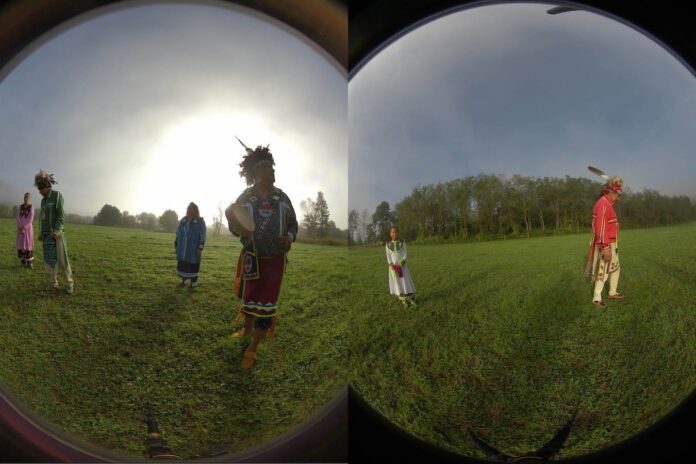DUBAI: This year’s Sharjah Biennial, which began Feb. 7, marks the events 30-year anniversary — highlighting the emirate’s longstanding cultural significance, both regionally and internationally.
The biennial has, throughout its existence, challenged postcolonial artistic and curatorial discourse and this year’s edition, SB15, maintains the biennial’s signature trajectory of providing a platform to examine artistic and cultural thought through decentralized, experimental displays of contemporary art.
This year, the Sharjah Art Foundation — responsible for the staging of the biennial — has brought together more than 150 artists and collectives from around the world under the banner, “Thinking Historically in the Present.”
Nusra Latif Qureshi, The Ideal Floral Background, 2013. (Supplied)
It is curated by Sharjah Art Foundation director Sheikha Hoor Al-Qasimi, but the theme was originally conceived by the late Nigerian curator, writer, art critic and historian Okwui Enwezor to reflect on the past 14 editions of the Sharjah Biennial and to examine the future of the art biennial model.
“Enwezor’s curation of Documenta11 (an art fair in Kassel, Germany) in 2002 had a major impact on my own curatorial consciousness, especially as it relates to the biennial model and its potential as a platform for knowledge accumulation, creative experimentation and social impact,” Al-Qasimi told Arab News.
“When I became director of the Sharjah Biennial the following year, Enwezor’s example was a formative influence on the institutional trajectory we mapped out for this platform. The 2003 edition of the biennial broke from the national pavilion model and focused instead on the liminal spaces of contemporary life along borders and in between cultures — a kind of decentralization that defined Enwezor’s curatorial intervention in Documenta11.”
Pipo Nguyen-Duy, Couple Walking Home, 2013. (Supplied)
Born in Calabar, Nigeria in 1963 and known for organizing large-scale exhibitions that challenged European and Western modes of representation, Enwezor was globally acclaimed for his groundbreaking approach to his work. He was Documenta’s first non-European artistic director and later curated “All The World’s Futures” — the 56th Venice International Art Biennale in 2015. He died of cancer in 2019.
In his New York Times obituary for Enwezor, art critic Jason Farago called him the “curator who remapped the art world” for his ability to challenge the status quo and give exposure to previously unheard voices — something SB15 celebrates and further examines.
“Okwui’s legacy of advocating for postcolonial perspectives — through his curation, writing and larger body of work — is arguably unparalleled,” Al-Qasimi said. “He is widely known as the most visible, influential, and respected curator to bring these perspectives into the broader global dialogue. His vision may be more relevant today than ever, as current social movements have caused renewed interest in embracing postcolonial perspectives and histories. Okwui was a key initiator of this — and put the foundations in place for all of us to carry forward this crucial discourse.”
Amar Kanwar, The Peacock’s Graveyard, 2023. (Supplied)
Enwezo understood the influence of the Sharjah Art Foundation and Biennial “within the larger project of advancing a postcolonial arts ecosystem and worldview,” Al-Qasimi said.
“In 2005, he first introduced to us to the phrase ‘Thinking historically in the present,’ which eventually became this edition’s guiding principle,” she added. “He believed that the ‘dislocation of belonging’ and the ‘disjunction of time’ were feelings that the postcolonial world, across different territories, had in common.”
Al-Qasimi says she asked Enwezor to curate SB15 because it would address ideas and experiences related to postcolonialism.
“We had many conversations before he passed away in which he made it clear that he wanted me build on the groundwork he’d laid out,” she adds. “Though we’ve expanded on his initial premise, it was important to me that this edition continued to be anchored in his decolonizing methodologies.”
Inuuteq Storch, Porcelain Souls, 2018. (Supplied)
As you might expect, this year’s biennial has a strong African focus, due to Enwezor’s influence and the foundation’s strong links to African art and culture.
“The foundation has a long-standing history of collaborations with pan-African networks, which was formalized in 2018 with the opening of the Africa Institute, an interdisciplinary academic research institute dedicated to the study, research and documentation of Africa and the African diaspora — the only one of its kind in West Asia, a historical nexus of African-Arab cultural exchange,” Al-Qasimi explained.
“This edition builds on these longstanding relationships, while forging new ones with some of the most urgent artistic practitioners whose work engages with various facets of Africa’s past and future in relation to global dialogue.”
The biennial features more than 300 works displayed at 19 venues across the emirate, including many new commissions. Al-Qasimi mentions works by Brook Andrew and Isaac Julien reflecting upon museum objects and their restitution, and by Destiny Deacon, Robyn Kahukiwa and Tahila Mintz asserting the significance of indigenous identities and values as highlights.
Meanwhile, in the works of Gabrielle Goliath, Amar Kanwar, Wangechi Mutu and Carrie Mae Weems, “individual histories are interwoven with collective notions of memory, grief and transformation,” she said.
“Inspired by Enwezor’s curatorial model, my own approach has involved reconsidering Sharjah’s position within global discourse, speculating on what our biennial could offer as a non-Western centre for the circulation of people and ideas, and how it could grow into a critical alternative to entrenched institutional thought,” Al-Qasimi continued. “This edition more empathically embraces Enwezor’s collaborative ethos.”

